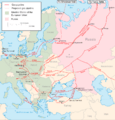Russia-Ukraine war facts for kids
Quick facts for kids Russo-Ukrainian War |
|||||||||
|---|---|---|---|---|---|---|---|---|---|
 The military situation as of 25 March 2022 Controlled by Ukraine
Occupied by Russia and pro-Russian forces
|
|||||||||
|
|||||||||
| Belligerents | |||||||||
|
Supported by
|
|||||||||
| Commanders and leaders | |||||||||
|
|
||||||||
| Casualties and losses | |||||||||
|
Civilian casualties
|
|||||||||
The Russo-Ukrainian War is an ongoing conflict between Russia and Ukraine. It started in February 2014. The war began after a big change in Ukraine's government. At first, the fighting was about Crimea and parts of the Donbas region. These areas are recognized by most countries as part of Ukraine.
For the first eight years, the conflict included Russia taking over Crimea in 2014. There was also a war in Donbas between Ukraine and groups supported by Russia. Other events included naval incidents, cyber attacks, and political disagreements. In late 2021, Russia gathered many soldiers near Ukraine's border. This led to the conflict growing much larger. Russia launched a "special operation" in Ukraine on February 24, 2022.
Contents
How the War Started
In February 2014, protests in Ukraine led to a revolution. The president at the time, Viktor Yanukovych, was removed from power. He was seen as friendly to Russia. After this, some people in Ukraine who supported Russia started protests.
Events in Crimea
Russian soldiers without official signs took control of important places in Crimea. They also took over the Crimean Parliament. Russia then held a vote, called a referendum, in Crimea. Most countries did not think this vote was fair. After the vote, Russia took over Crimea.
Conflict in Donbas
In April 2014, protests by pro-Russian groups grew into a war. This happened in the Donbas region of Ukraine. The Ukrainian military fought against groups supported by Russia. These groups had declared their own "republics" in Donetsk and Luhansk.
Russia's Involvement
In August 2014, Russian military vehicles crossed into the Donetsk region. They did not have any clear markings. An undeclared war began. Ukrainian forces fought against separatists and Russian troops. Russia tried to hide that its soldiers were involved. The fighting then became a static conflict, like in a trench war. There were many attempts to stop the fighting, but they failed.
In 2015, Russia and Ukraine signed agreements called Minsk II. However, disagreements stopped these agreements from being fully put into action. By 2019, Ukraine said that 7% of its land was "temporarily occupied." The Russian government later admitted its troops were in Ukraine.
Escalation in 2022
In 2021 and early 2022, Russia gathered a very large number of soldiers near Ukraine's borders. NATO, a military alliance, said Russia was planning to invade. Russia denied this.
Russia's Demands
Russian President Vladimir Putin said that NATO growing bigger was a threat to Russia. He demanded that Ukraine should never be allowed to join NATO. He also said that Ukraine did not have the right to exist. He wrongly stated that Ukraine was created by Soviet Russia.
Invasion of Ukraine
On February 21, 2022, Russia officially recognized the two self-declared regions in Donbas. These were the ones that had limited recognition from other countries. Russia then openly sent its troops into these areas. Three days later, on February 24, 2022, Russia invaded Ukraine.
World's Reaction
Many countries around the world have strongly criticized Russia's actions. They said Russia broke international law. They also said Russia violated Ukraine's right to be an independent country. Because of this, many countries put economic sanctions on Russia. These sanctions also targeted Russian people and companies.
Images for kids
-
Residents of Kyiv with Sich Battalion volunteers on 26 August 2014
-
Pro-Russian rebels in Donetsk in May 2015. Ukraine declared the Russia-backed separatist republics from eastern Ukraine to be terrorist organizations.
-
From left, Russian President Vladimir Putin, French President Emmanuel Macron, German Chancellor Angela Merkel and Ukrainian President Volodymyr Zelenskyy in Paris, France, December 2019
-
Ukrainian deputy prime minister Olha Stefanishyna with NATO secretary-general Jens Stoltenberg at a conference on 10 January 2022 regarding a potential Russian invasion
-
A U.S. intelligence assessment map and imagery on Russian military movement nearby the Ukrainian border, as on 3 December 2021. It assessed that Russia had deployed about 70,000 military personnel mostly about 100–200 kilometres (62–124 mi) from the Ukrainian border, with an assessment this could be increased to 175,000 personnel. Published by The Washington Post.
-
Peace march in Moscow, 21 September 2014
-
Pro-Russian supporters in Donetsk, 20 December 2014
-
Ukrainian refugees in Kraków protest against the war, 6 March 2022
See also
 In Spanish: Guerra ruso-ucraniana (2014-actualidad) para niños
In Spanish: Guerra ruso-ucraniana (2014-actualidad) para niños



















